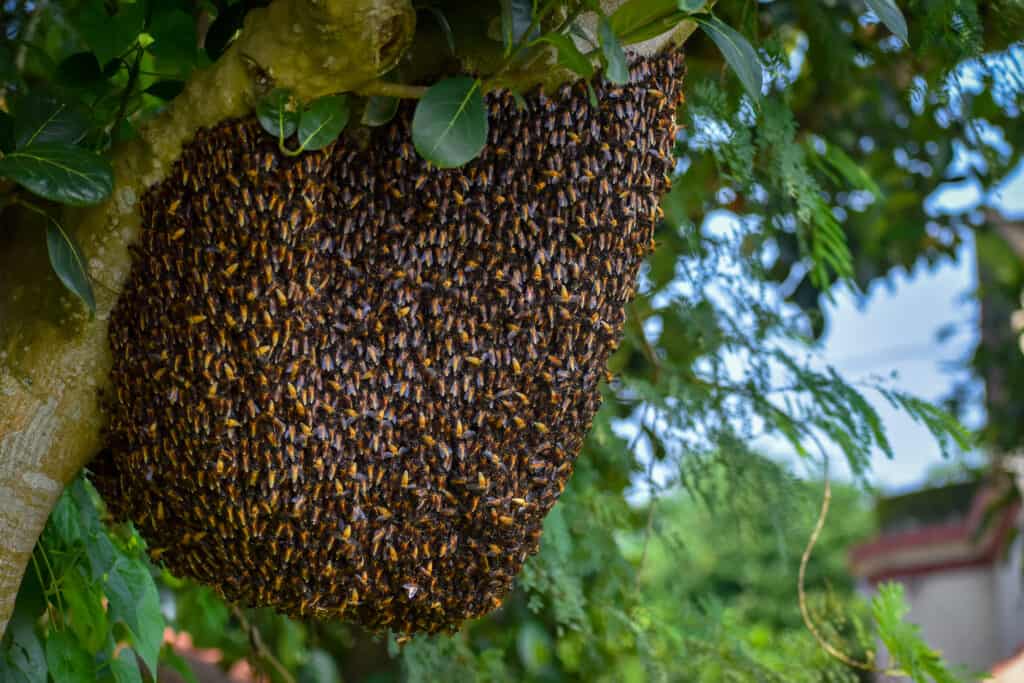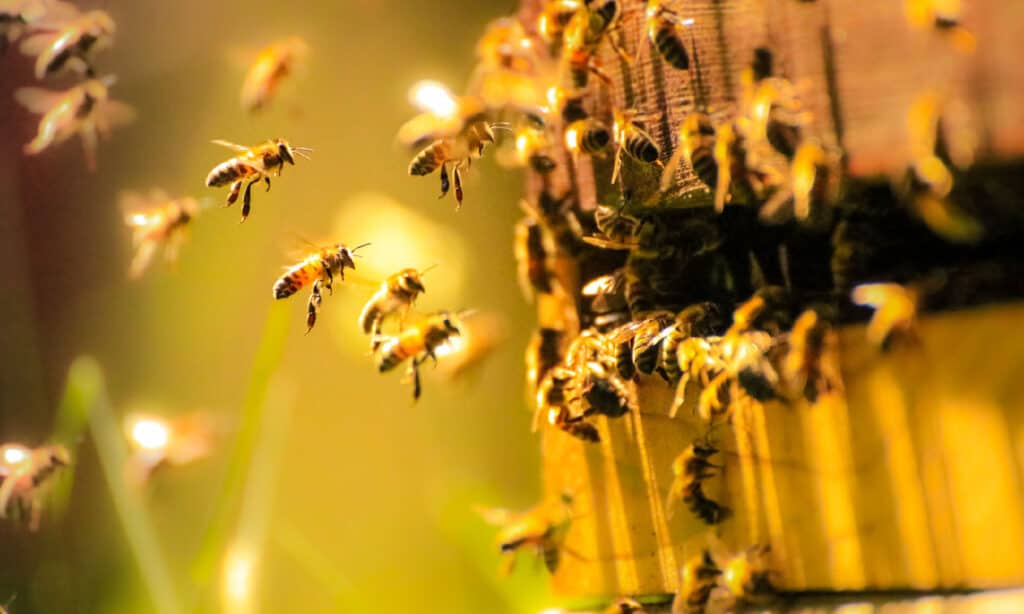In a beehive, the queen bee is the center of the colony. She is the only female bee that lays eggs. The worker bees dedicate themselves to caring for the queen. They feed her, clean her, and keep her cool. The queen rarely leaves the hive after mating. She stays protected inside, served by the workers.
But sometimes, the worker bees will kill their queen bee. This might seem surprising since she is so important. However, the workers have good reasons for removing an old queen.

Some queen bees can lay over 3,000 eggs in just one day.
©iStock.com/Inventori
The Queen’s Egg Laying Declines
In the prime of her life, a queen honey bee has an incredible egg-laying capacity. She can lay up to 1,500-2,000 eggs per day, the highest egg production rate of any insect worldwide. Some bees can even lay more than 3,000 eggs daily. The queen can sustain this amazingly high reproductive rate for around 2-3 years. During this peak period, she ensures the rapid growth and prosperity of the colony. Her prolific egg-laying results in a hive teaming with up to 60,000 busy bees all working together at the height of summer.
However, as the queen bee ages, her egg-laying abilities slowly decline. The queen generally lives between 2-5 years. Once she is older than three years, her egg production drops off noticeably. An aging queen may lay only a few hundred eggs daily rather than the robust 1,500 of her youth. Older queens also tend to lay more unfertilized drone eggs than fertilized eggs that develop into the all-important female worker bees the hive needs.
The intelligent worker bees are finely tuned to the queen’s egg-laying rates and the overall needs of the colony. When they sense the queen is failing and unable to maintain adequate egg production, the workers will start to raise new queen larvae in specially constructed queen cells.

A queen bee can get sick from several different causes.
©tuncarif/Shutterstock.com
The Queen Gets Sick or Injured
Queens can get sick from various causes, including parasites, viruses, bacterial infections, and physical injuries. The Varroa mite is one of the most dangerous parasites affecting honey bee queens. These tiny mites attach themselves to the queen and feed on her hemolymph (insect blood). A heavy Varroa infestation can weaken and even kill a queen. The mites also act as vectors, transmitting viral diseases like deformed wing viruses. Queens are also susceptible to fungal and bacterial diseases that can make them too weak to lay eggs properly.
Physical injuries, such as a damaged wing or leg, can also incapacitate a queen. Queens must be able to fly to mate, so an injured wing prevents her from leaving the hive to mate with drones. A damaged leg impairs her ability to walk across the comb to lay eggs. Without the queen laying fertilized eggs, the colony is doomed.
When it becomes clear the queen is too sick or injured to continue fulfilling her duties, the worker bees will remove her from the hive and kill her, a process known as supersedure. This is necessary to prevent the spreading of contagious diseases to other colony members. It also signals to the workers that it is time to raise a new queen to take over the leadership of the hive. The death of the old queen makes room for this new queen to take her place.
The new queen will begin laying eggs within a few weeks, and the cycle will continue. Losing a queen is always a significant disruption, but the highly organized bee society has evolved methods to replace failed queens and ensure the colony’s continuation quickly.

With up to 3,000 eggs daily, a nest can get overly crowded.
©Nandalal Sarkar/Shutterstock.com
The Hive Gets Too Crowded
During the warm summer months, the brood nest of a thriving honey bee colony can become very congested. With the queen laying up to 3,000 eggs daily, the hive can quickly become overpopulated. When a hive gets too crowded, the queen’s pheromones have difficulty effectively dispersing throughout all the comb and bees. Her control over the colony weakens when the workers can’t detect her presence as strongly.
The crowded, stressful conditions also encourage the workers to construct queen cells. When the worker bees sense the queen is losing her influence, they take matters into their own hands.
As soon as the first new virgin queen emerges, half of the workers will form a swarm with the old queen and leave the hive to find a new home. This swarming process relieves the overcrowding and allows the colony to expand and form two nests. However, the old queen must be killed after the prime swarm leaves. If she returns to the original hive, she may try to kill the new developing queens, disrupting the colony. The workers violently ball and suffocate the old queen to protect the authority of the new queen.
Killing the former queen after swarming ensures a proper succession process can take place. The young virgin queen that remains can then take over the original hive. She will quickly get mated and start laying eggs to repopulate the diminished colony. The swarming instinct and queen killing allow the bees to maintain a strong queen and prevent overcrowding.
There Are Rival Queens
Having multiple queens present in a hive simultaneously inevitably leads to conflict. Virgin queens may appear even when the mother queen is still healthy and productive. There are a couple of reasons why the workers start rearing new queens when the current monarch is doing fine:
1. The colony is getting ready to swarm
Workers start queen cells in preparation for a prime swarm leaving with the old queen. The remaining virgin will take over the original colony.
2. Insurance against queen failure
The workers raise new queens if the reigning queen declines or dies unexpectedly. This ensures immediate replacements are available.
Regardless of why the new virgins appear, having more than one queen in a hive is extremely disruptive. The old queen will seek out and attempt to kill any newly emerged virgin queens she encounters. She wants to maintain her unchallenged reign over the colony. However, the younger, more vigorous virgin queens often prevail in these queen-on-queen battles.
If multiple virgins emerge simultaneously, the worker bees may intervene to make the queens fight to the death. This ritualized battle is the ultimate showdown to determine who will gain the right to rule the colony. The workers circle the dueling queens, essentially refereeing the combat. The last queen standing emerges victorious while the dead rivals are dragged out of the hive.
Having the queens directly battle eliminates indecisiveness and enables the colony to move forward under new leadership. The sole surviving queen has proven her strength and ability to defend the hive. She will then take over the all-important egg-laying duties and provide the colony with a new generation of bees. The queen-on-queen duels resolve the crisis of having too many queens and restore order.

Bees can tell if a queen is not related to the colony.
©iStock.com/William Jones-Warner
The Queen is Not Related to the Colony
Rarely, a colony rejects and kills a new queen introduced by a beekeeper. Bees can tell if she is genetically different by her pheromones and sounds. They will swarm and ball her to death if she is an outsider. They understand the importance of being related. So they do not accept an unfamiliar, foreign queen from another hive.
It seems harsh that bees kill their mother queen. But to the bees, the needs of the colony come first. When a queen can’t reproduce, the workers replace her without sentiment. This allows the hive to survive. The workers’ only drive is protecting the continuity of their colony. They do what is necessary for future generations of bees.
Killing the queen is not a betrayal but an instinctive decision by the hive mind. The queen’s life only has value if she is useful to the colony. When she loses her purpose, her reign must end. In the captivating realm of bees, the sentiment holds no sway when the destiny of the hive hangs in the balance.
Conclusion
Queen bees have privileged lives. But they still must obey the pragmatic laws of the colony. Workers do not hesitate to remove old, sick, or unproductive queens. By replacing failing queens with new ones, the hive continues to thrive. Bees have no emotional attachment to a particular queen. Their focus is entirely on perpetuating their colony. The bees’ unwavering practicality and willingness to depose human-like monarchs provide an illuminating perspective on loyalty and sacrifice.
The photo featured at the top of this post is © iStock.com/Inventori
Thank you for reading! Have some feedback for us? Contact the AZ Animals editorial team.






